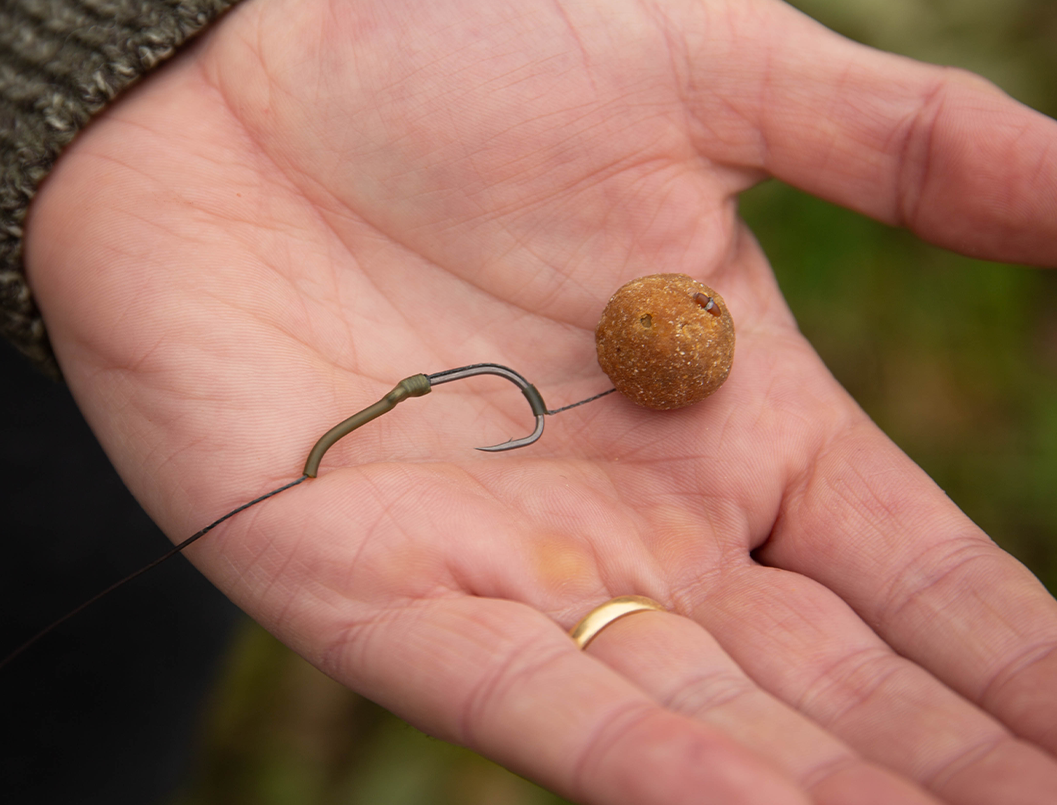Gareth Fareham gives us an in depth look at his preparation and yearly rituals to get the most of those first rays of Spring when the carp finally wake up
LEWIS READ LOOKS IN-DEPTH AT THE FUNCTIONALITY OF KICKERS AND EXTENSIONS!
Why on earth would you actually want to ‘faff’ about with kickers or extensions? Especially when a simple old world knotless knot, combined with a good hook pattern, will catch you carp? Well, the answer is simple; more carp hooked, better hook holds, improved re-setting after a pickup, more consistent presentation, and ultimately more carp in your net.
The core principles that underpin the correct application and benefits of hook extensions and kickers are pretty well set-in stone… In the simplest of terms, adding a length of tubing to extend the shank of a hook essentially moves the fulcrum point (turning point), which would normally be around the hook eye, further away from the hook-point. That way the weight of the hook, along with any inherent angle will enhance the way a rig works, essentially making it react faster and more aggressively during the time the hook is in the fish’s mouth. This could be anything an aggressive suck and blow, when the bait is in and out the carp’s cavernous mouth in an instant, to a fish deeply and confidently inhaling the hook bait and then moving its head so the hook link tightens and bingo.
Oh, if only they always fed like that, carp angling would be so much simpler…. The old Sav’s anglers worked this out in the late 80’s and early 90’s with the miraculous advent of the ‘Loony Extension’ and since then the application of extensions and kickers has evolved into an art form.
THE APPLICATION OF EXTENSIONS AND KICKERS HAS EVOLVED INTO AN ART FORM!

Hooking arrangement will almost always react most aggressively when the hookbait (and hook) has been inhaled fully into the carps’ mouth. When the hook link tightens, through it reaching its full extension, the beneficial effects of the enhanced hooking mechanism comes into play – with the hook turning more aggressively, targeting the bottom lip ensuring the hook point takes hold securely a little further inside the bottom lip.
Having the extension also means that the hook point is kept facing the fish’s lip, after likely being inhaled blunt bit (bend) first. Without the hook less able to flip easily around so it blows out backwards, you’re immediately adding a massive degree of control and therefore consistency.

Think of the benefits being like those afforded by a classic stiff rig - tangle free and super consistent presentation - but with the facility to combine it with all manner of hooklink materials, enabling us even broader variation of hooklink materials and lead arrangements. Ultimately, this means we should be able to tailor our rigs even more effectively to every individual angling scenario, especially bait type, size and buoyancy.


It is also not unreasonable to think of another key benefit of an extension in terms of pushing the weight of the hook further forward too, a bit like adding a little weight onto the hook point. However, the actual mechanics are a little more complex than that simple analogy, as you can add in ‘kicks’ to improve the hooks turning function, by forming an angle in the shrink tube as it cools down.

WE SHOULD BE ABLE TO TAILOR OUR RIGS EVEN MORE EFFECTIVELY TO EVERY INDIVIDUAL ANGLING SCENARIO AND SITUATION.
An option to a rigid shrink tube extension would be to use a fine baiting or sewing needle to thread the hooklink through the tubing in an old-school ‘line aligner’ way. This creates a precisely fixed exit point that can then be aligned precisely to the hook-point. This ensures that the final rig works as well as it possibly can. Even though this may seem to be a trivial detail, the alignment of the hook-point with the exit point of the hooklink makes a tremendous difference to the rig's efficiency.
Of course, application of this tweak with a kirbed or reversed bend hook pattern needs to be adjusted to allow for the slant of the point, but as most modern carp hook patterns feature a non-reversed bend it will work whichever direction the carp approaches the baited rig.
Don’t feel compelled to only use shrink tube with the line-aligner arrangement. The inherent rigidity, that's so vital to creating an effective extended kicker can conversely make fine tuning the exit point of the hooklink (to sit directly in alignment with the hook point) blooming awkward. I also like the feel of a silicon line aligner, that tends to only be around 5-6mm down the hooklink from the hook eye, but you need to be fussy about the silicon. Luckily the 1mm TA silicone seems just about perfect for this application…
STEP-BY-STEP
TO LEWIS' LINE ALIGNER RIG
DEEP PENETRATION
Unfortunate victims (readers) of any of my previous articles on hook mechanics, may recognise the other key benefit of elongating the hook-shank, namely reducing the critical ‘angle of attack’ so the hook point can penetrate with minimal resistance. Most kickers or extensions do this naturally, reducing force required to bed the hook down to the bend – safe and secure.
Then there is the bonus benefit of kickers effectively enlarging the hook, and this may be particularly useful if you’re targeting really big carp either in the UK or in Europe.
There’s absolutely no doubt that increasing the scale of the hook helps create a more effective hooking mechanism when targeting monster carp, and by using a kicker you can create the same effect as using a bigger hook, without the encumbering weight of all that additional steel.


DECISIONS, DECISIONS...
So, how do you decide on the length and style of kicker to use with certain set-ups, and what factors dictate how you incorporate one into your tried-and-tested rigs?
Well, the main factors to consider are the hooklink material and the hook shape/pattern. The greatest benefit has always been when they are used with braided hook links (obviously that includes skinned hook links with sections stripped back). This is because the pivot point allows unrestricted rotation as the hook is free to twist and turn.
But what precisely is ‘right’?
Well, essentially you want to create a hooking mechanism that reacts quickly and consistently taking hold whether you’re using the good old finger ‘flip test’ or the ‘drag across the palm’ method. These are both great tools for assessing the tuning of a rig, and whereas some balanced presentations may not react as anticipated with a hookbait in place out of the water they give a good feel for how the rig will react.
Carp fishing hooks vary in so many ways, but the key features that you need to consider when deciding what length and shape of hook shank extension to use are the angle of the eye and the general shape and weight (wire gauge) of the specific pattern.

First, it is safe to say that most hooks can be used in conjunction with extensions and kickers. As a guide, hooks with slightly in-turned eyes, such as the Curve Point have proven the perfect partner to the Noodle style extension that are quite long. Whereas Curve Shank style hook patterns are better in combination with slightly shorter extensions of up to 1.5 -2cm in length (measured from the hook eye). Go any more ‘radical’ than that, and you run the risk of ‘closing off’ the gape of the hook, as most patterns with a curve shank also feature an in-turned eye that wants to kick the extension inwards…
There will always be a significant variation in how rigs work when different combinations of hooklink materials and even hook sizes are used. It really is best to sit and tie a few combinations up, testing they're reactions on your pal or over your finger and then adjust the hair exit point to suit the buoyancy of your chosen hookbait.
YOU JUST NEED TO INVEST A BIT OF TIME INTO PLAYING WITH YOUR PERSONAL FAVOURITE COMPONENTS TO GET A RESULT THAT YOU'RE 100% HAPPY WITH!


HOOKBAIT SELECTION
I personally only apply kickers to bottom bait rigs and balanced rigs. My logic is that I can easily create the same flip affect with a pop-up by using different hooklink materials, like super stiff Recoil, but in a far less conspicuous manner. Balancing a rigs aesthetics with the mechanics is still important as I don’t only fish at night!
In terms of visibility, having a long hook shank extension suspended a few inches off bottom under the pop-up makes it highly visible, whereas with bottom baits the tubing is less obvious as it sits flush to the lakebed, far less conspicuous by a feeding fish.
READY-MADE PERFECTION
There is another option to tinkering with pieces of shrink tube and silicone, and that readymade kickers that you can buy, that you thread onto the hooklink, and away you go. They tend to be designed to work with most hooks, and they don’t need steaming either, making them perfect for anglers that are either utterly disorganised (like me!) or just want the improved rig performance to hand in a convenient form. Lovely! So, whether you want to create an aggressive withy style extension or the perfect Noodle then you know where to look...*Available now*







